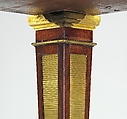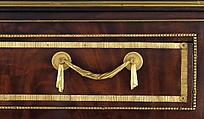On loan to The Met The Met accepts temporary loans of art both for short-term exhibitions and for long-term display in its galleries.
Architect's table
David Roentgen German
This mechanical table has a rectangular double-hinged top veneered with flame-grained mahogany. It can also serve as a console. A horizontal molding, on which reading, writing, and drawing materials may be propped, emerges automatically when the top is raised. Below is a long frieze drawer decorated with milleraies banding and moldings and mounted with drapery-swag handles. The interior is fitted with a leather-covered writing slide above a nest of moveable drawers. The square, tapering legs decorated on all sides with millerailles panels have gilt-bronze profiles and moldings and brass block feet. Because of the expense associated with gilding, the molding on the tops of the three legs were gilded only on the three visible corners. All four legs are screw-topped to permit easy transport. Latches underneath the tabletop can be turned outward to hold adjustable candlesticks.
Relying for its effect on beautifully figured polished mahogany and exquisite metal mounts rather than on colorful marquetry, the present piece is typical of David Roentgen’s neoclassical style. It also represents a late stage in the long evolution of this model’s design (see Wolfram Koeppe. Extravagant Inventions, Princely Furniture of the Roentgens. Exh. cat. The Metropolitan Museum of Art, New York; 2012–2013. New York, 2012, nos. 8 and 17, pp. 68–69 and 92–93; a multifunctional commode, Hessische Hausstiftung, Museum Schloss Fasanerie, Eichenzell/Fulda, Germany, inv. no. FAS M124, and an architect’s table, House Collection, Dumbarton Oaks, Washington, D.C., inv. no. F390). More than forty versions of this type of table are known, differing only in the degree of their embellishment, the materials used, and the round or square shape of the legs. An invoice indicates that in a shipment of 1786 Catherine the Great received no fewer than nine such tables "for writing while sitting and standing."[1] The versatility of the smaller versions made for her grandsons (see Koeppe, op. cit., no. 43, pp. 158–59; a children’s architect table, The State Hermitage Museum, Saint Petersburg, inv. no. EPR-48) must have persuaded the empress to order more.[2] Several examples are still in Russian collections, including one at Pavlovsk Palace (see Koeppe, op. cit., fig. 76, p. 162).[3] An engraving after Roentgen’s original design was illustrated in a 1795 edition of the Weimar Journal des Luxus und der Moden.[4] The accompanying text describes the table in enthusiastic detail, asserting that it was ideal for the "businessman who must write to many people, frequently, and at length."[5]
The French call this form a table à la Tronchin, after the Swiss physician Théodore Tronchin. An advocate of the value of fresh air, exercise, and a moderate lifestyle, Tronchin would have recommended it to patients who worked many hours in a seated position.[6] Roentgen supplied an architect’s table to the Prussian court (see Koeppe, op. cit., fig. 42, p. 43; After Friedrich Wilhelm Klose. The King’s Writing Room, Crown Prince Palace (detail). ca. 1861. Watercolor, 10 1/4 x 10 3/8 in. (26.1 x 26.2 cm). Hessische Hausstiftung, Museum Schloss Fasanerie, Eichenzell/Fulda, Germany (StaD, D23, case 11/32),[7] and a nearly identical example belonged to Édouard Colbert de Maulévrier, French minister plenipotentiary to the archbischop-elector of Cologne (who was also a patron of Roentgen’s.[8] Colbert may have visited the famous workshop at Neuwied and acquired the fine mahogany table himself. A portrait of him and his family seated at it suggests that he marquis was very proud of his purchase of "Neuwied work" (see Koeppe, op. cit., fig. 35, p. 36; artist unknown. Édouard Colbert de Maulévrier and His Family. ca. 1792. Oil on canvas. Whereabouts unknown.).
[Wolfram Koeppe 2012]
Footnotes:
[1] Tsentral’nyi Gosudarstvennyi Istoricheskii Arkhiv, Saint Petersburg, archive 468, inventory 1, part 2, file 391, sheet 163, no. 17 (Dietrich Fabian. Abraham und David Roentgen: Das noch aufgefundene Gesamtwerk ihrer Möbel- und Uhrenkunst in Verbindung mit der Uhrmacherfamilie Kinzing in Neuwied. Leben und Werk, Verzeichnis der Werke, Quellen. Bad Neustadt an der Saale, 1996, pp. 365–66, doc. no. 2.230 [translated from the French; ill. in facsimile, pp. 366–67]).
[2] Fabian (Abraham und David Roentgen: Das noch aufgefundene Gesamtwerk ihrer Möbel- und Uhrenkunst in Verbindung mit der Uhrmacherfamilie Kinzing in Neuwied. Leben und Werk, Verzeichnis der Werke, Quellen. Bad Neustadt an der Saale, 1996, p. 59, nos. 89, 89a) mentions the existence of a second example.
[3] See Josef Maria Greber. Abraham und David Roentgen: Möbel für Europa. Werdegange, Kunst und Technik einer deutschen Kabinett-Manufaktur. 2 vols. Starnberg, 1980, vol. 2, p. 321, ill. nos. 643–45; Alexandra Alexejewa and Rifat Gafifullin in Alexandra Alexejewa and Rifat Gafifullin in Krieg und Frieden: Eine deutsche Zarin in Schloss Pawlowsk. Exh. cat. Haus der Kunst, Munich; 2001-2. Munich and Hamburg, 2001, pp. 346–47, no. 22 (illustrated in situ).
[4] See Josef Maria Greber. Abraham und David Roentgen: Möbel für Europa. Werdegange, Kunst und Technik einer deutschen Kabinett-Manufaktur. 2 vols. Starnberg, 1980, vol. 1, p. 261; Achim Stiegel. Präzision und Hingabe: Möbelkunst von Abraham und David Roentgen. With contributions by Burkhardt Göres. Exh. cat. Kunstgewerbemuseum, Staatliche Museen zu Berlin; 2007; Bestandskatalog des Kunstgewerbemuseums 24. Berlin, 2007, pp. 138, 139, fig. 21a.
[5] Quoted in Bernd Willscheid in Die Möbelkunst des David Roentgen in Gotha: Neue Aspekte im Wirken eines grossen Ebenisten. With contributions by Burkhardt Göres, Bernd Schäfer, Michael Sulzbacher, Bernd Willscheid, and Heinrich Jobst Graf von Wintzingerode. Edited by the Gesellschaft der Freunde für Möbel- und Raumkunst e.V., Fulda. Gotha, 2008, p. 40, no. 4.
[6] Nicole de Reyniès. Le mobilier domestique: Vocabulaire typologique. 2 vols. Principes d'analyse scientifique 5. Inventaire général des monuments et des richesses artistiques de la France. Paris, 1987, vol. 2, p. 1133, ill. nos. 4290, 4291.
[7] It can be seen with its top raised in a watercolor after Friedrich Wilhelm Klose of King Frederick William III’s study (see Koeppe, op. cit., fig. 42, p. 43; The King’s Writing Room, Crown Prince Palace (detail). ca. 1861. Watercolor, 10 1/4 x 10 3/8 in. (26.1 x 26.2 cm). Hessische Hausstiftung, Museum Schloss Fasanerie, Eichenzell/Fulda, Germany (StaD, D23, case 11/32).
[8] Rieunier & Associés, Drouot-Richelieu, Paris, sale cat., March 26, 2003, lot 179. For some similar examples, see Rudolph Lepke’s Kunst-Auctions-Haus, Berlin, sale cat., May 12–13, 1931, lot 208 (example with round legs); Celia Jackson Otto. "David Roentgen: Ébéniste Mécanicien." Magazine Antiques 77, no. 1 (January 1960), pp. 105, ill. no. 11 (also in Christie’s, New York, sale cat., May 20–21, 1987, lot 101).
Due to rights restrictions, this image cannot be enlarged, viewed at full screen, or downloaded.
This artwork is meant to be viewed from right to left. Scroll left to view more.









